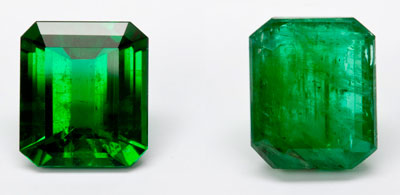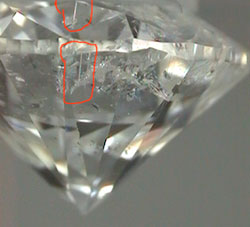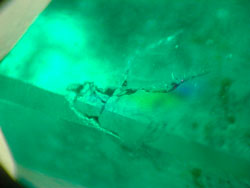If You Don't Ask, They Don't Tell
"My most lasting impression is how hard jewelers make shoppers work to obtain information about jewelry."
The quote is from the editor of a prominent jewelry trade magazine, writing to his readers — jewelers.
Most insurers would readily agree with the editor's observation. They see the lack of information in appraisals every day.
WHAT don't jewelers tell?
JCRS studied jewelry appraisals submitted to 21 insurance companies in 16 states. The study found that most appraisals didn't give enough information to distinguish one piece of jewelry from another, much less to arrive at a valuation or price a replacement.
The 4 Cs. With diamonds, the 4 Cs — Carat weight, Color, Clarity and Cut — are all necessary to determine value. Yet clarity grade appeared on 64% of the appraisals studied, color on 61%, and even something so basic as carat weight appeared on only 57%. A mere 1% of the appraisals bothered to mention cut, the single attribute that most affects the diamond's quality and price.

Color & Clarity. The emerald on the left is valued at $40,000,
the one on the right at $3,000. Color and clarity must be disclosed.
Color. For colored gemstones, the color — expressed as saturation, tone and hue — is the most important determinant of value. All three qualities are needed to accurately represent the color. For example, a ruby might be described as "vivid (saturation) dark (tone) purplish red (hue)" rather than simply as "red." On the appraisals studied, only 49% gave hue, 32% gave tone, and just 5% gave saturation.

Laser-drilling Treatment. Though it appears as only a speck from the top of the stone, the line is actually a laser drill hole made to remove unattractive inclusions. Such holes weaken the stone and significantly lower its valuation.
Gem Treatments. Many gem treatments are done to conceal defects in a lower quality stone, making it more pleasing to the naked eye. So it's not surprising that, since very basic information is often left out, gem treatments are even less likely to be covered. Treatments such as fracture filling and clarity enhancement must be disclosed by the seller, since they cannot be recognized by the jewelry purchaser or, in the event of a claim, by the insurer. Also, such treatments can break down, revealing the original low-quality stone. If the treatment is not mentioned on the appraisal, the breakdown could be interpreted as "damage" and the insurer would be liable. An appraisal that neglects to mention such treatments is actually cheating the consumer and the insurer.

Fracture-filling Treatment. The filled fracture is not visible to the naked eye but is very apparent under the microscope. This is not “damage” for which the insurer is liable.
WHY don't jewelers tell?
Underwriters and agents don't necessarily know how jewelry is valued — that is, what information should be on an appraisa l— but a trained jeweler does. If crucial information is left off an appraisal, it is because the jeweler
- is not a competent gemologist, or
- is deliberately concealing information in order to inflate prices, or
- doesn't know how the insurer uses appraisals, or
- doesn't care since it's "just for insurance."
FOR AGENTS & UNDERWRITING
How do you know whether an appraisal submitted by a policyholder has the necessary information? If the appraisal is on the ACORD >78 or 79 form, it is complete. The appraiser who uses and signs this form certifies that he or she is a graduate gemologist of the Gemological Institute of America and has successfully completed formal classroom insurance appraisal training in jewelry. The appraiser warrants that the jewelry has been examined in a gem lab, that all qualities are as stated, and that treatments not part of the normal handling of such a stone are stated on the appraisal. The valuation is an estimate of the current replacement cost at the appraiser's store.
The ACORD appraisal is your assurance that the valuation is not inflated, and that there is sufficient information to price a replacement if a claim should ever be made. It explicitly states that the appraisal is being provided to both the customer and the insurer. Above the appraiser's signature, the ACORD >78/79 does not carry the common disclaimer that the jeweler assumes "no liability or responsibility" for the appraisal. This means the appraiser is a professional who takes legal responsibility for his work.
If the policyholder's appraisal is not on an ACORD form, and if it is obviously inadequate (for example, if the total appraisal is "Lady's gold and diamond ring, $2000"), insist on one that is more complete. Recommend that the policyholder get an appraisal by a Certified Insurance Appraiser™, a gemologist who is also trained in appraising for insurance. Explain to the policyholder how a detailed appraisal is to her benefit: it is a record of what exactly she owns and, in the event of damage or loss, it assures that her replacement will match the quality of the original.
FOR CLAIMS
Ideally, the claim you are settling comes with an ACORD >78/79 appraisal. You then have all the information you need and can go about your business of getting the best price on a replacement.
But what if you are faced with a non-ACORD appraisal? Check its completeness using ACORD >18, the Jewelry Underwriting and Claim Evaluation form. The purpose of this form is to analyze appraisals for necessary descriptive content. It allows you to put information from a "narrative" appraisal into an easy-to-follow format. You can see on the form what information is required for each type of jewelry. This is the information you'll use when talking to a jeweler about a replacement.
If crucial information is missing from your description, the replacement jeweler will have to guess, and the quality of the replacement may not measure up to the original.
The ACORD >78/79 appraisal warrants that unusual or deceptive gem treatments are explicitly stated and that synthetic gems are specified, but other appraisals may simply not mention them. Yet this is crucial information. Some treatments can drastically lower the value of a gem, and synthetics are generally worth less than natural stones. See the February and April issues for hints on tracking down synthetics and gem treatments.
Check the January issue for tips on how to proceed if ACORD >18 reveals that your appraisal is inadequate.
CIA™ Corner
In most issues of IM NEWS, this space relays a professional experience by a Certified Insurance Appraiser™. These stories give glimpses into the jewelry industry and show how widespread are the problems caused by lack of information about jewelry, whether through inadequate training, nondisclosure or deliberate deceit. Like consumers, insurers need jeweler/appraisers they can trust.
Certified Insurance Appraisers™ are generally the only jeweler/appraisers using ACORD >78/79. To date, only CIA™ jewelers are trained in understanding the insurance company's needs and way of doing business.
"The ACORD form isn't a magic bullet but it carries the legal language that puts the insurer in a first party position to recover for errors and omissions by the appraiser," says David W. Hendry, Jr., President and CEO of JCRS. "These CIAs™ understand that to clean up the industry takes responsibility for one's work and standardizing the content of appraisals."
©2000-2024, JCRS Inland Marine Solutions, Inc. All Rights Reserved. www.jcrs.com

